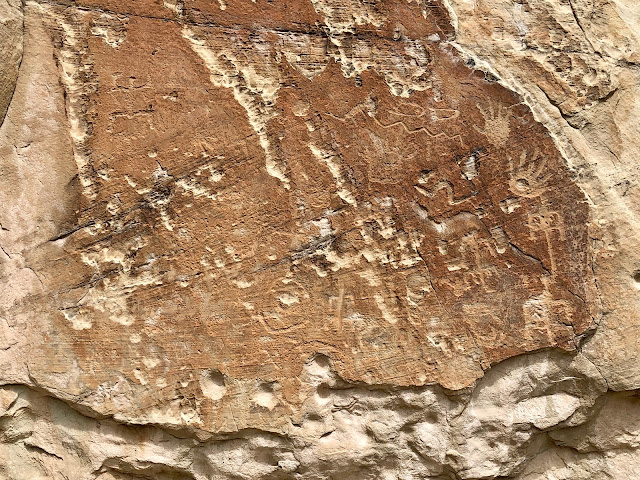We took a detour on our way back to Tucson from Abiquiu, to visit El Morro National Monument. “Located on an ancient east-west trail in north western New Mexico, the monument preserves a large pueblo built around 1275 AD, atop a sandstone promontory with a pool of water at its base. The large sandstone outcropping became a landmark, so that through several centuries, hundreds of petroglyphs were carved by ancestral Puebloans, and explorers and travelers left inscriptions carved into the walls.
The 875 room mesa top pueblo was home to about 1500 people, situated on the Zuni-Acoma Trail, an important prehistoric trade route. Spanish explorers visiting the area in the 16th century referred to the promontory as El Morro, and early Anglo-Americans called it Inscription Rock. With its oasis like source of water, El Morro was a stopping place for travelers in an arid, desolate region. The oldest historic inscription at El Morro, left by Juan de Onate, the first Spanish governor of the colony of Santa Fe de Nuevo Mexico, is dated April 16, 1605. Petroglyphs and carvings made by Ancestral Puebloans were inscribed centuries before Europeans arrived.
El Morro was designated a national monument by President Theodore Roosevelt in 1906, with US federal law prohibiting further carving on the cliffs from that year.” It is a special place.
The 875 room mesa top pueblo was home to about 1500 people, situated on the Zuni-Acoma Trail, an important prehistoric trade route. Spanish explorers visiting the area in the 16th century referred to the promontory as El Morro, and early Anglo-Americans called it Inscription Rock. With its oasis like source of water, El Morro was a stopping place for travelers in an arid, desolate region. The oldest historic inscription at El Morro, left by Juan de Onate, the first Spanish governor of the colony of Santa Fe de Nuevo Mexico, is dated April 16, 1605. Petroglyphs and carvings made by Ancestral Puebloans were inscribed centuries before Europeans arrived.
El Morro was designated a national monument by President Theodore Roosevelt in 1906, with US federal law prohibiting further carving on the cliffs from that year.” It is a special place.












